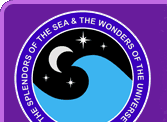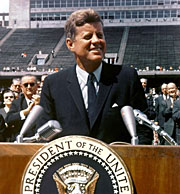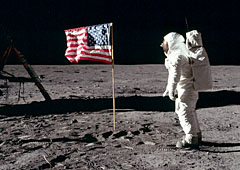1961


NASA Public Domain Image
April 12, 1961
First Man in Space
Russian cosmonaut Yuri Alekseyevich Gagarin becomes the first human being to venture into space. The Vostok 1 spacecraft makes one complete orbit around Earth in 108 minutes, and reaches altitudes of 112 to 203 miles (180 to 327 kilometers). This historic flight lasts only one hour and 48 minutes.


NASA Public Domain Image
May 5, 1961
First American in Space
On May 5, 1961, Astronaut Alan Shepard becomes the first American to be launched into space on the first flight of the Mercury program. Riding atop a Mercury-Redstone 3 rocket, his suborbital flight lasts only 15 minutes. During this time he experiences about 5 minutes of "weightlessness" and tests the maneuvering capability of his Mercury capsule, known as Freedom 7.

May 25, 1961
President Kennedy's Historic Speech
On September 12, 1962, just 20 days after Alan Shepard's flight, President John F. Kennedy makes his historic speech at Rice University. He challenges the nation to land "a man on the Moon and return him safely to Earth" before the end of the decade. Kennedy characterizes space as a new frontier, invoking the famous pioneer spirit from America's past.
1962

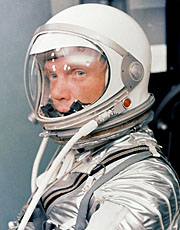
NASA Public Domain Image
February 20, 1962
First American in Orbit
Astronaut John H. Glenn is launched into orbit by an Atlas LV-3B launch vehicle. Glenn becomes the first American to orbit the earth on board his spacecraft, named Friendship 7. He makes a total of 3 complete orbits and the total flight time is 4 hours and 55 minutes. The total distance traveled is 65,763 nautical miles (121,793 kilometers).
1965

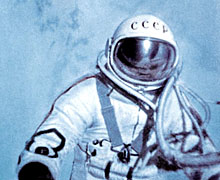
Wikipedia Public Domain Image
March 18, 1965
First Spacewalk
Commander Pavel I. Belyayeu and Pilot Alexei A. Leonov are launched into Earth’s orbit orbit aboard the Russian spacecraft Voskhod 2. Alexei Leonov later performs the first tethered spacewalk outside of his spacecraft while in Earth’s orbit. Known as an Extravehicular Activity (EVA), this historic venture into space lasts only 12 minutes. Due to the stiffness of the spacesuit in a vacuum, Leonov has to vent air from his suit in order to fit back into the capsule.

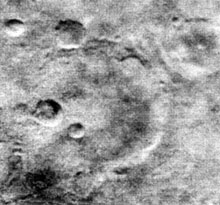
NASA Public Domain Image
July 14, 1965
First Close-up Images of Mars
NASA's Mariner 4 spacecraft arrives at Mars and gave scientists their first views of the planet at close range. The spacecraft passes within 6,118 miles (9,846 kilometers) of the red planet's surface.The resulting photos showed no sign of the famous "canals" and no evidence of life.
1966

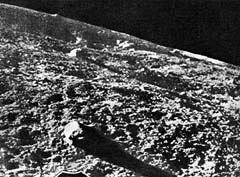
NASA Public Domain Image
February 3, 1966
First Spacecraft to Land on the Moon
The Russian spacecraft Luna 9 completes a trip of 250,000 miles (402,336 kilometers) and successfully becomes the first spacecraft to make a soft landing on the Moon. Luna 9 transmits pictures of the Moon's surface back to Earth. The mission demonstrates that the Moon's surface is strong enough to support the weight of a large spacecraft.

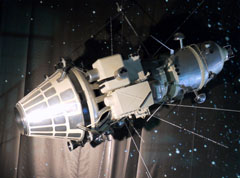
Pline / CC BY-SA 3.0
April 3, 1966
First Moon Orbit
The Russian spacecraft Luna 10 becomes the first spacecraft to orbit the Moon. The spacecraft operates for 460 lunar orbits and makes and 219 active data transmissions before radio signals are discontinued on May 30. During this time, Luna 10 conducts extensive research while in lunar orbit, gathering data about the strength of the Moon's magnetic field, its radiation belts, and the nature of lunar rocks.


Wikipedia Public Domain Image
June 2, 1966
First American Spacecraft on the Moon
Surveyor 1 becomes the first American spacecraft to make a soft landing on the Moon just four months after the first Moon landing by the Soviet Union. After a journey of 63 hours and 36 minutes, Surveyor 1 successfully lands only 9 miles (14.5 kilometers) away from its intended target in the Oceanus Procellarum. The spacecraft transmits more than 10,000 high-resolution photographs back to Earth before its energy sources are depleted.
1967

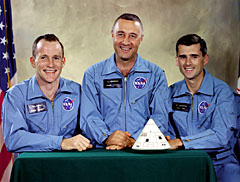
NASA Public Domain Image
January 27, 1967
First U.S. Space Tragedy
During a routine test of the Apollo 1 spacecraft on the launch pad, a spark causes a fire in the crew compartment of the Command Module. Astronauts Gus Grissom, Ed White, and Roger Chaffee, are killed in this tragic incident. It is later determined that faulty wiring caused the spark, and the pure oxygen environment in the capsule was to blame for the rapid spreading of the blaze. This incident caused NASA to discontinue the use of pure oxygen in favor of a nitrogen-oxygen mix for future tests.

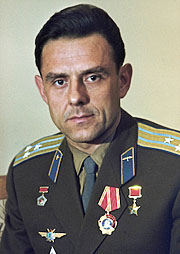
Wikipedia Public Domain Image
April 24, 1967
First Spaceflight Casualty
The Soviet Union launches its Soyuz 1 mission on April 23, carrying cosmonaut Vladimir M. Komarov. After 18 orbits, The spacecraft fires its retrorockets to reenter the Earth's atmosphere. To slow the descent, the drogue parachute is deployed, followed by the main parachute. However, due to an unexpected defect, the main parachute fails to unfold. The capsule crashes during re-entry, killing Komarov on impact.


Rave / CC BY-SA
October 18, 1967
First Venus Probe
The Soviet space probe Venera 4 sends a capsule to descend into the atmosphere of the planet Venus, returning data about its composition. It is the first successful probe to perform in-place analysis of the environment of another planet and the first probe to conduct a chemical analysis of the Venusian atmosphere.
1968

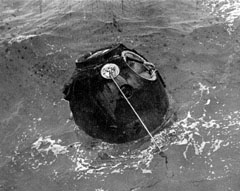
Image Credit: S.P.Korolev RSC Energia
September 15, 1968
First Moon Orbit and Return
The Soviet Zond 5 probe is launched. It becomes the second spacecraft to orbit the Moon and the first to return safely to Earth. The spacecraft carries the first terrestrial organisms to the Moon, including two tortoises, fruit fly eggs, and plants. Zond 5 was originally planned to take cosmonauts around the Moon, but the failures of previous Zond spacecraft led the Soviets to send an unmanned mission instead.


NASA Public Domain Image
October 11, 1968
First Manned Apollo Mission
Apollo 7 becomes the first manned Apollo mission into space with Walter M. Schirra, Jr., Donn F. Eisele, and Walter Cunningham. This test mission makes 163 orbits of the earth with a total mission time of 10 Days, 20 minutes. The test flight checks life-support, propulsion, and control systems for the new Apollo spacecraft.

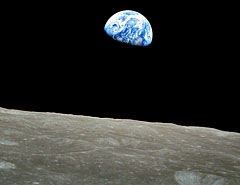
NASA Public Domain Image
December 21, 1968
First Manned Moon Orbit
Apollo 8 is launched with Frank Borman, James A. Lovell, Jr. and William A. Anders. It is the first Apollo mission to use the new Saturn V rocket, and the first manned spacecraft to orbit the Moon, making 10 orbits during its 6-day mission. It is during this mission that the historic "Earthrise" image of the earth above the lunar surface is captured from orbit as the spacecraft circled the Moon.


NASA Public Domain Image
December 7, 1968
First Image of the Whole Earth
The Apollo 8 spacecraft captures the first image of the whole earth from a distance of about 18,641 miles (30,000 kilometers). In this historic image, South is at the top, with South America visible at the covering the top half center, with Africa entering into shadow. North America is in the bottom right.
1969

July 20, 1969
First Manned Moon Landing
After nearly running out of fuel, the Apollo 11 Lunar Module, nicknamed "Eagle", makes a successful landing on the surface of the Moon. Astronauts Neil Armstrong and Edwin Aldrin, Jr. become the first human beings to set foot on another world. Many experts still consider this to be the single greatest technological achievement of 20th century.
1970

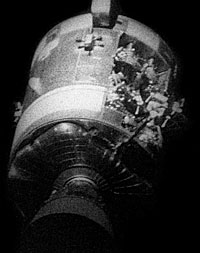
NASA Public Domain Image
April 11, 1970
Apollo 13 Launch
Apollo 13 is launched, suffering an explosion in the Service Module oxygen tanks. The planned Moon landing is aborted, and the entire world watches as James A. Lovell, Jr., John L. Swigert, Jr. and Fred W. Haise, Jr., struggle for days to survive. Due mainly to the innovation and imagination of engineers back home, they are able to return safely to Earth after several harrowing days in space.

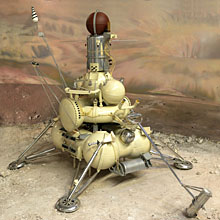
Bembmv / CC BY-SA
September 12, 1970
First Automated Return of Lunar Soil Samples
The Soviet Luna 16 spacecraft is launched, conducting the first successful return of lunar soil samples to the earth by an automatic spacecraft. A drill located on the craft penetrates the lunar surface to collect a soil sample. This sample is then deposited into a small spherical capsule on the spacecraft's upper stage which later lifts off for its return trip back to Earth.

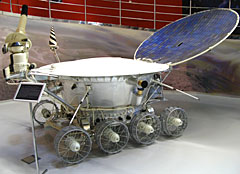
Petar Milošević / CC BY-SA
November 17, 1970
First Robotic Lunar Mission
Luna 17 lands on the Moon with the first automatic robot, Lunokhod 1. Driven by a five-man team back on Earth, the craft travels over the lunar surface for 11 lunar days (322 Earth days). During this time, it returns 20,000 TV images and 206 high-resolution panoramas in addition to performing a host of experiments including soil analysis.

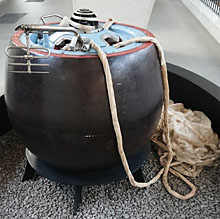
Stanislav Kozlovskiy / CC BY 4.0
December 15, 1970
First Soft Landing on Another Planet
The Soviet Venera 7 spacecraft lands on the surface of the planet Venus and becomes the first probe to make a soft landing on another planet. In spite of the hellish conditions, the craft is able to transmit data for 23 minutes. The probe provides valuable information about the surface of Venus, which cannot be seen through the planet's thick atmosphere of clouds.
